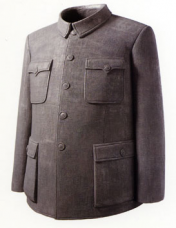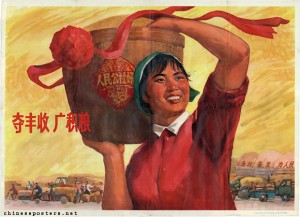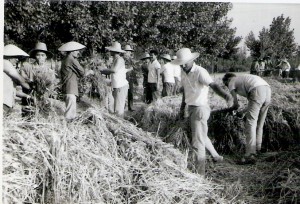Chairman Mao envisioned a unified society in which ethnic, gender, and class inequalities were nonexistent. His ideal society was in direct opposition to the Western imperialism, specifically capitalism, that had inhibited the political and economic growth of China. Removing these inequalities was part of his efforts to bolster national pride in China.
need a transition between the two paragraphs
Chairman Mao introduced the Mao Suit to China in the late 1950’s with the effect being to “‘Civilize the mind and make savage the body.’ This is an apt saying. In order to civilize the mind, one must first make savage the body. If the body is made savage, then the civilized mind will follow.” (Chen 361). Chairman Mao took this to mean that the body is meant to be improved upon, to be strengthened. He wanted to uplift the proletariat class, who traditionally performed manual labor, and highlight their value to Chinese society.
The Mao suit was a button-down shirt with either pants or trousers, denoting one’s occupation as a proletariat or farmer, respectively. The peasant workers wore trousers to show off their “well-formed calves” and rolled up their sleeves to show off their “powerful arms” (Chen 365). how about focus on the analysis of gender and mao suit?
 A Grey MaoSuit
A Grey MaoSuit
For Chinese women, the Mao suit created an opportunity to be equal with men. Each profession had a standard uniform that every worker was required to wear, and workers were evaluated on many tasks they completed during their shifts. Mao eliminated the benefits that beauty and propriety had initially given upper-class women. In addition, men and women worked alongside each other, and were encouraged in the same manner to strengthen their bodies and increase their productivity levels. Through the Mao suit and changing ideals of professionalism in the workplace, Chairman Mao achieved political, economic, and social uniformity among Chinese people, regardless of their ethnicity and other marginalized aspects of their identity.
 ‘Strive for an abundant harvest, amass grain 1973’
‘Strive for an abundant harvest, amass grain 1973’
However, Mao’s cultural uniformity eliminated the concept of femininity altogether. In advertisements and propaganda promoting the communist agenda, women were portrayed as hard-working individuals who were happy because they focused solely on their occupations. Women had short hair that was tucked under a hat or hair-wrap, and wore little to no makeup. The uniforms were shapeless so as to direct attention to the parts of the body that were visible (i.e. arms and legs). By forcing women to build muscle and work harder in the fields or in the offices of proletarians, Chairman Mao sent the message that equality could only be established by having both men and women conform to the standards of appearance and productivity initially forced upon men.
 Farmers during the Cultural Revolution, 1970
Farmers during the Cultural Revolution, 1970
Women’s bodies were in flux when it came to changing professions. In the agricultural sector, every individual wore the same suit and completed the same tasks. In the proletariat/technocratic fields, such as the textile industry, women had to wear different clothes to both signify their upward mobility and cover different parts of their body. Men, on the other hand, continued to wear trousers and button-down shirts. They did not have to alter their clothing in order to conform to the rules of different workplaces.
Overall, Mao did not achieve his quest for gender equality. Women could not engage in traditional beauty or fashion practices because they were required to focus on work and gaining strength. The shapeless Maosuit did not allow women to showcase their bodies. Women did not have uniform clothing, but were forced to change their garments when they changed professions. While unintentional, the gender inequality between men and women resulted because the standards for equality were not recreated to include the cultures and identities of women before the cultural revolution. Instead, women were forced to meet the societal standards placed upon men.
could pursue a much more cohesive organization, if take the thematic issue of gender (in)equality in terms of Mao uniformity as the central focus, then explain in detail, how the visual denotations construct socialist female body.
Works Cited:
Grey Mao Suit: http://kolahun.typepad.com/kolahun/2010/11/s.html
Strive for an abundent harvest: http://chineseposters.net/themes/women-2.php
Farmers during the Cultural Revolution, 1970: http://resourcesforhistoryteachers.wikispaces.com/WHII.34
